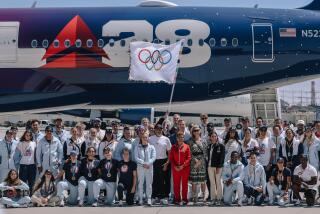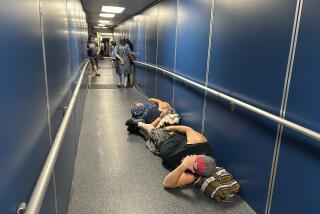New Federal Security Mandates Mean Financial Crunch for Major Airports
WASHINGTON — Dozens of major airports across the country, including Los Angeles International, face a massive funding shortfall as they seek to meet a Dec. 31 deadline for installing explosives detection machines required by Congress, officials with the U.S. Conference of Mayors said Friday.
The gap at LAX is more than $120 million, and Los Angeles Mayor James K. Hahn warned that the shortfall could interfere with meeting the deadline for putting the devices online.
“We won’t be able to install them; we will run out of money very quickly,” Hahn said. “If we’re going to be part of this effort to provide homeland security, we are going to need some help. We don’t believe the funding has been forthcoming.”
Elsewhere, officials estimate costs of $50 million to $86 million in Atlanta and $24 million in St. Louis. And this is just one of a range of arenas in which someone--the federal government, state and local government or the private sector--will have to pay the high cost of protecting the United States from terrorist attacks such as those of Sept. 11.
Congress required in November that all checked luggage--about 1 billion bags a year nationwide--be screened with explosives detection equipment by the end of this year. The most advanced machines use computerized tomography technology similar to that employed by hospitals to look at the body’s soft tissues. Roughly the size of a sport utility vehicle, a machine costs $1 million, plus $1 million to install. The federal government will pay the cost of procuring the machines; the dispute is over installation costs.
The $120-million shortfall at LAX is more than half of what it budgets in a typical year for all capital improvement projects, including safety upgrades to reduce the airport’s high risk of runway collisions.
At a smaller Los Angeles-area airport, Ontario International, officials estimate that the cost of installing the detection equipment will range from $4.8 million to $6.4 million, with an expected federal contribution of $2.8 million. Figures were not available for Burbank and John Wayne International airports.
Fort Worth Mayor Kenneth Barr said Dallas-Fort Worth International faced a total bill of $195 million and expected the federal contribution to cover only a fraction.
“Is it necessary?” Barr asked. “I don’t know. But I don’t think that as elected officials responsible for the safety of this facility, we can ignore the threat. The cost is absolutely mind-boggling. But the cost of not doing it could be greater.”
Barr said the Dallas-Fort Worth airport may have to raise its fees on airlines, which would result in higher ticket prices. At LAX, Hahn said, rising security costs could lead to layoffs and pressure to slow down safety improvements.
Local officials say the funding crunch stems from a decision by the Bush administration to budget only $175,000 as the federal share of installing each scanner. Previous Federal Aviation Administration estimates put the installation cost at about $1 million for each machine. In many cases, floors have to be reinforced and walls torn down to accommodate the units.
“We definitely recognize that there is going to be some budgetary challenge in meeting the requirements,” said Jonathan Thompson, a spokesman for the new federal Transportation Security Administration. He cautioned that the estimates by the airports might turn out to be high, because the agency had yet to decide the mix of devices that would be used for scanning bags.
Sen. Patty Murray (D-Wash.), chairwoman of the transportation appropriations subcommittee, said the administration’s $175,000 appeared “woefully low.”
“I am concerned that we are starting to see a pattern of the administration indicating that they want to have aviation security on the cheap,” Murray said. “It was precisely because we didn’t make the necessary security investments in the past that we were so vulnerable Sept. 11.”
Hahn said LAX estimated it would need 150 of the most sophisticated bomb detection machines. The federal contribution of $175,000 per machine for installation would come to about $26 million. But the total installation cost could top $150 million.
Fewer than 200 of the machines are being used at airports around the country, including Los Angeles International. An estimated 2,990 would be needed to cover all 429 airports with regular airline service, at a cost of more than $2.5 billion, plus installation. All told, the cost of fortifying the nation’s airports is expected to exceed $6 billion in the current fiscal year.
Federal officials have urged the mayors to tap into grants that Congress already provides to expand airport capacity and improve safety. But local officials say that’s not the answer.
“We certainly don’t want to rob Peter to pay Paul here,” Hahn said. “We want to do runway safety, but we also want to make sure every passenger and every piece of baggage is screened.”
More to Read
Sign up for Essential California
The most important California stories and recommendations in your inbox every morning.
You may occasionally receive promotional content from the Los Angeles Times.









